| A long avenue with cypresses
leads up to Agia Triada, and this makes, if possible, the sight of the
impressive monastery even more magnificent. In the Turkish period the
monastery was also known under the name of "selvili monastir",
the monastery with the cypresses. |

|
 |
As other monasteries from the
end of the Venetian period, Agia Triada is constructed as a fortress in
order to be utilized in the defence against the Turkish attack threat,
which became more evident every day.
|
| The high bell tower was not
built until the end of the 19th century - after the repeal (1856) of the
muslim law, prohibiting bells in the Orthodox churches.
|
| Before entering the
monastery,
it is worth noticing the two doors at each corner of
the facade. The one to the left leads into the storeroom, where the oil is
kept, and where earlier the oil mill was placed. Above the door is an
amusing inscription, playing with the words eleo and eleos,
meaning respectively olive and mercy. The inscription reads
as follows:
|
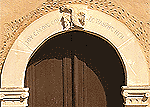
|
|
ΤΟΥ
ΕΛΕΟΥΣ ΣΟΥ Κ(ΥΡΙ)Ε
ΠΛΗΡΗΣ Η ΓΗ
Lord, the world is filled with
your mercy
|
|
|
|
|
|
which can easily be
misread as: Lord, the world is filled
with your olives.
|
|
The high door to the
right leads into the storeroom, where the monastery's wine is
kept. Above the door is a surprising inscription:
|

|
ΤΗΔ
ΕΝΙ ΠΑΙΣ
ΣΕΜΕΛΗΣ ΦΙΛΕ
ΧΡΥΣΟΚΟΜΗΣ
ΔΙΟΝΥΣΟΣ. Α Χ Ι
Γ
Here, my friend, is the golden
haired son of Semele, Dionysus. 1613 |
| Referring to Dionysus, the
ancient god of wine, on a Christian building, is due to the Venetian
worship of the mythology of antiquity. The year 1613 is furthermore the
oldest date existing in the monastery.
|
| You enter the monastery via a
large flight of stairs, appearing from the outside to lead up to the
second floor. From the inside, however, you will discover that
you still stand on ground level. It is because of the level differences of
the terrain and has been utilized by building the storerooms and a large
reservoir for accumulation of rainwater.
|
| Above the high
entrance door is the following inscription, referring with its triple
repetition to the monastery's name of Agia Triada (Holy Trinity).
|
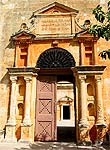
|
|
ΗΝ
ΚΑΙ ΗΝ ΚΑΙ ΗΝ
ΑΛΛ' ΕΝ ΗΝ ΚΑΙ
ΕΣΤΙ ΚΑΙ ΕΣΤΑΙ |
|
ΦΩΣ
ΚΑΙ ΦΩΣ ΚΑΙ
ΦΩΣ ΑΛΛ' ΕΝ ΦΩΣ |
|
ΕΙΣ
ΘΕΟΣ ΟΝΤΩΣ,
ΑΧΛΑ' |
|
There was and was and
was, but there was only one, is one and shall in all future be one, |
|
light and light and light, but
only one light, |
|
|
indeed one God, 1631 |
|
|
|
|
|
|
| First you enter the roofed
entrance hall. To the left is the entrance of the monastery's museum, exhibiting in
tree consecutive rooms icons, cassocks, relics, manuscripts, ancient books
and other documents from the time before the destruction of the monastery
in 1821. But because of the above-mentioned lootings of the monastery, the
number of exhibited items is limited.
|
| To the right is the monastery's
shop, where you can buy for example icons, postcards, homemade raki and
ecological olive oil.
|
| From here you go out into the court dominated by the impressive
church. From in front the church looks like a square building, but by
walking around it you will discover its complexity of small side wings,
almost all of them with cupolas. On each side of the entrance are two
inscriptions saying in respectively Latin and Greek, that the monastery
was founded by Ieremias and Lavrentios Tzangarolos.
|
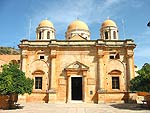
|
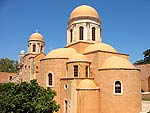 |
The nave is dedicated to The
Holy Trinity, but the church building contains a further four aisles: to
the left of the entrance the Chapel of the Life-giving Spring (i.e. Virgin
Mary), (Zoodochou Pigis), and to the right the Chapel of John the
Theologian (Agiou Ioannou tou Theologou). On the floor above are the
Chapel of The Holy Apostles (Agion Apostolon) and the Chapel of the
Crucifixion (Stavroseos). The two last-mentioned were built in 1854. |
| In the monastery court you
should notice the grafted citrus fruit tree to the right of the church. It
carries oranges as well as lemons, limes and mandarins. A sign on the tree
reads:
|
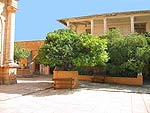
|
| "This tree was
planted in 1830 by a monk from the monastery and was later grafted tree
times by Ioannis Paterakis from
Kalorrouma. Paterakis died in 1970 at the age of 95."
|
| In the south-eastern
corner of the monastery are the monks' cells along a cloister leading to
the bone-house, where the mortal remains of the dead monks are kept, among
them also the remains of the two founders.
|

|
| At the end of the cloister, a flight of stairs leads up to the monks'
burial church. It is dedicated to The Saviour (Sotiros) and stood there as early as 1645.
|
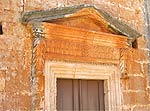 |
Above the entrance door is this
significant inscription:
|
ΝΟΥΣ
ΕΣΤΙΝ Ο ΔΙΑΚΟΣΜΩΝ
ΤΕ ΚΑΙ ΠΑΝΤΩΝ
ΑΙΤΙΟΣ
The mind is the creator of
beauty and is the cause of everything.
|
|
|
|
 |
The monks' burial place was
originally at the back of the court, but during the construction of the
theological seminary, the graveyard was moved to the Agios Nikolaos church
- about 1 km further along the road towards the Gouverneto monastery. |
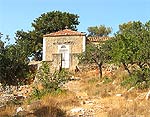
|
|
|
|
|
|
|
Read three foreign
travellers' descriptions of their visits to the monastery:
|
|
F.
W. Sieber (1817) |
Robert
Pashley (1834) |
Vittorio
Simonelli (1893) |
|
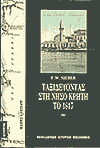
|
 |
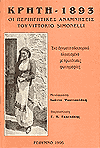
|
|
|
|
|
|
|
|
|
|














